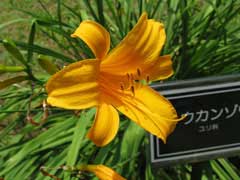
Latin Name: Hemerocallis aurantiaca
USDA Hardiness: 5-9
Native Range: TEMPERATE ASIA: China (Guangdong Sheng, Guangxi Zhuangzu Zizhiqu), Japan (Kyushu)
Edibility Rating: 4 / 5
Medicinal Rating: 1 / 5
Region:
Family:
Plant Type:
Medicinal Uses
Edible Uses
Edible Parts: Flowers Leaves Root Shoots | Edible Uses: Leaves and young shoots - cooked[105, 177]. They must be consumed when very young or else they become fibrous[K]. Flowers and flower buds - raw or cooked. The tubular flowers are about 7.5cm long and 13cm in diameter[205]. Each stem carries 6 - 8 flowers[205]. The flowers contain carotene and starch[105, 177]. The flower buds contain about 43mg vitamin C per 100g, 983 IU vitamin A and 3.1% protein[205]. Root - raw or cooked. A radish-like flavour but not so sharp[205].
Cultivation
Succeeds in most soils[1], including dry ones, preferring a rich moist soil[205]. Grows well in heavy clay soils. Succeeding in sun or shade, it produces more flowers in a sunny position though these flowers can be shorter-lived in very sunny positions[205]. Succeeds in short grass if the soil is moist[1]. Prefers a pH between 6 and 7[200]. Hybridizes freely with other members of this genus[200]. The roots have spindle-shaped swellings[205]. The cultivar 'Major' is smaller than the type species, but has larger flowers, it is sometimes cultivated for these edible flowers in Japan[205]. There is some doubt as to whether this cultivar really is a form of H. aurantiaca[205]. Individual flowers are very short-lived, opening in the morning and withering in the evening[205]. Plants take a year or two to become established after being moved[1]. Plants seem to be immune to the predations of rabbits[233]. The plants are very susceptible to slug and snail damage, the young growth in spring is especially at risk[200]. There is some doubt as to the origins of this plant, it might have arisen in cultivation at Kew[205]. It is cultivated in Japan, where it is believed to have come from China[58]. It is quite possibly a hybrid since it is sterile unless fertilized by another species[233].
Known Hazards
Large quantities of the leaves are said to be hallucinogenic. Blanching the leaves removes this hallucinatory component[205]. (This report does not make clear what it means by blanching, it could be excluding light from the growing shoots or immersing in boiling water[K].)
Habitats
Thickets, grasslands and streamsides at elevations of 300 - 1000 metres in Guangdong, Guangxi, and Taiwan[266].